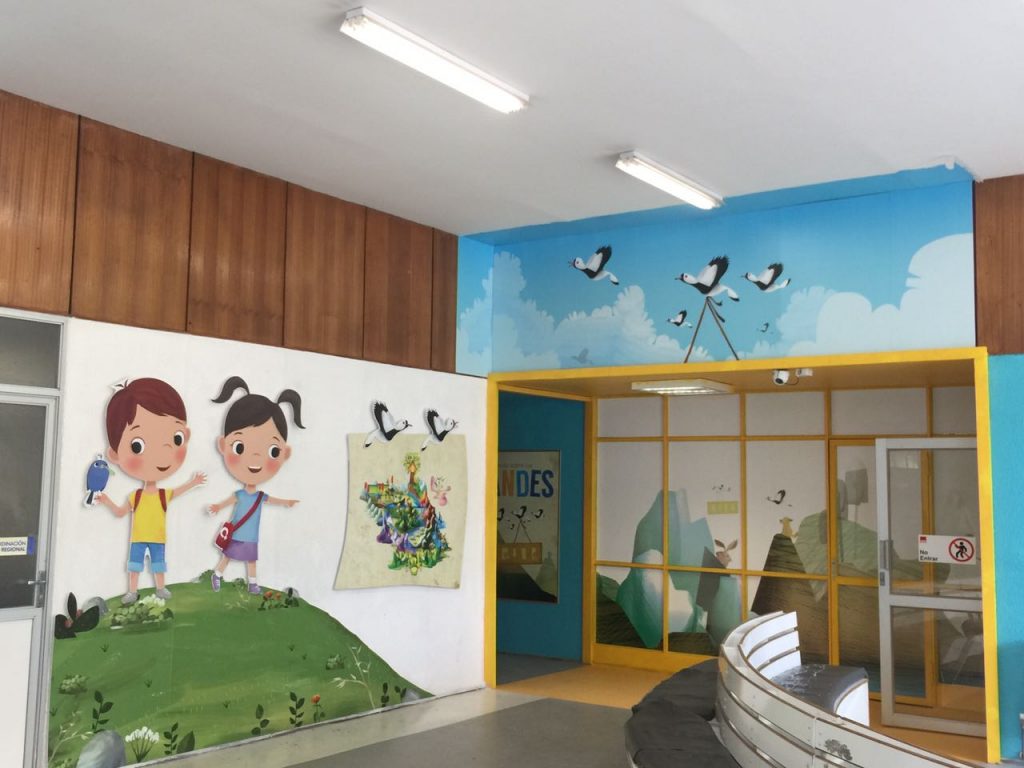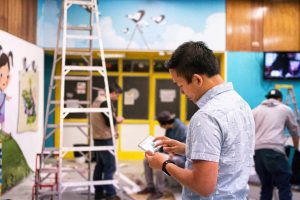Archive for the ‘Wayfinding’ Category
COANIQUEM – Safe Niños Part 2
On my third meeting with the students, a small core of three teams remained, each continuing the project through a second term. Each team presented their projects that had matured and were ready to take back to Chile to install. The first student, Alvin, presented the story and animal characters his team had created to help guide the children through the magic land through which they would be “flying” as they went on their healing journey.  The land, complete with a colorful map that resembled a cross between Middle Earth and Candy Land, was, like Chile – long and narrow, flanked with whimsical mountains peopled by the trees and animals of Chile.
The land, complete with a colorful map that resembled a cross between Middle Earth and Candy Land, was, like Chile – long and narrow, flanked with whimsical mountains peopled by the trees and animals of Chile.  The waiting room was to be the entrance to this magical kingdom, and the doors leading to treatment rooms along the long hallways were to be decorated with charming animal characters inviting the young patients in. There was even a passport that the children and their families would receive when they arrived in the waiting room, to be stamped in every treatment room when they received their compression garments, physio- or occupational therapy.
The waiting room was to be the entrance to this magical kingdom, and the doors leading to treatment rooms along the long hallways were to be decorated with charming animal characters inviting the young patients in. There was even a passport that the children and their families would receive when they arrived in the waiting room, to be stamped in every treatment room when they received their compression garments, physio- or occupational therapy.
Then students Behnia and Anna presented their solution to motivate the teens, who had been returning to the clinic for years for multiple treatments: a “Teen Zone” flanked by mural-painted shipping containers that were already being used for storage on the site. The area would be covered with colorful sail shades and was made attractive to teens with a dance area and hammocks.
Finally, Nicholas and Dave presented their low and hi tech brightly colored “toys,” designed to help the children participate in physio- and occupational therapy treatments to increase mobility and activity, and reduce stress. The design challenge that they were solving was how to provide the therapists measureable feedback on the progress of treatment, while motiving the kids with musical and visual feedback.
It was a remarkable display, accomplished over a few short months. The passion of the students shone through. An added benefit: the project had inspired the staff, the patients, and their families with pride for COANIQUEM and its cutting edge treatments, giving them happiness and hope for healing, even before the projects were installed. Then, to top it off, one of the students – Alvin, won a grant to complete his project and fly back to Chile to install it, launching his career while doing good in the world. What better outcome could there be!
COANIQUEM – Safe Niños Part 1
It started out with informal phone calls from my daughter Penny, when she and her partner Dan began working on their latest project in South America – advising COANIQUEM, a children’s burn center in Santiago, Chile. COANIQUEM’s Founder and Director, Dr. Jorge Rojas had asked Designmatters, a United Nations NGO within Pasadena’s ArtCenter College of Design, to make the spaces less scary and more inviting for their patients.Designmatters’ Director Mariana Amatulo, turned to Penny and Dan, as lead faculty for such South American Pacific Rim projects, to spearhead the initiative. After several phone calls from Penny asking my advice, we decided to formalize the relationship, and I became an official advisor, to help them turn COANIQUEM into a healing space.
The burn center serves over eight thousand child burn patients per year from across all of South America. It is a monumental task, as more than 7 million children are burned per year in Latin America, over seven times the burn rate in the developed world. More like a small village than a hospital, COANIQUEM includes a long-term care clinic, surgical outpatient services, physiotherapy, occupational therapy, a school, a chapel, and housing for the long term patients.
The Designmatters teams – usually two to three faculty and ten to twelve ArtCenter students, work closely with the NGOs and communities they are serving, to identify their greatest needs, and come up with design solutions together. It is truly social entrepreneurship working with, not just for the people who will benefit. The COANIQUEM project was named “Safe Niños” – to continue the theme that their first project, “Safe Agua” had begun.
I gave my first lecture to the ArtCenter student group shortly after they had returned to LA from their first trip to Chile. They had lived on site at COANIQUEM for two weeks, staying in the same dormitories as the families and patients. They had spent their days talking with and observing the day-to-day activities of all the staff, the patients, and their families, to identify their greatest needs and wishes for improvements.
At that point the students had barely formed their small group teams, and some had only a vague idea of their plans of action. So our interaction was mostly didactic – I gave my PowerPoint presentation on “Healing Spaces,” outlining elements of place that can stress or calm. When I came to the slide of me in Disneyland, on my 2008 behind-the-scenes-tour when I was researching my book Healing Spaces, the students nearly leaped out of their seats and begged me to please, please get them a behind-the-scenes tour of Disneyland too! At first I laughed at the idea, but then figured it was worth a try.
The design issues at COANIQUEM were much the same as those with which Disney’s Imagineers dealt when designing the theme park: how to move people through a space without being there to guide them every step of the way, and at the same time bringing them from fear and anxiety to hope and happiness. COANIQUEM had an entrance, long hallways, and many buildings that needed to be made easier to navigate and less threatening to the kids.
As soon as I returned to Tucson, I e-mailed Bruce Vaughn who, as VP of Disney Imagineering had given me the tour in 2008. He had since risen to Chief Creative Officer of Disney Imagineering, and enthusiastically arranged the tour for the group. He, and all the Imagineers we met were happy to apply their skills and talents to training the next generation to do good in the world through design. 
It was wonderful to watch the students drink in every word, some taking notes, many taking pictures, and all seeing the Park through the eyes of burgeoning young design professionals.
To be continued….
